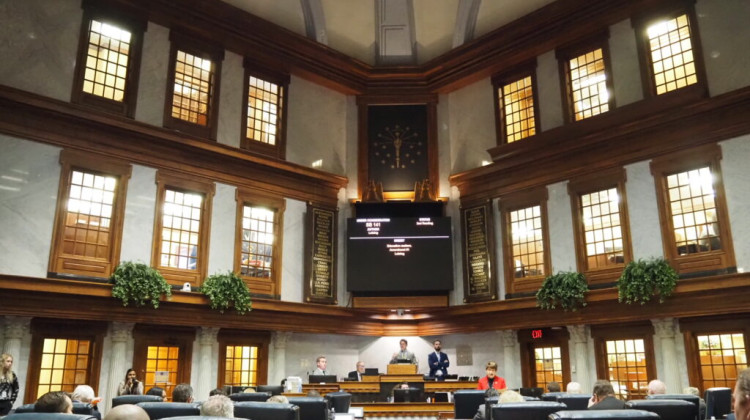
SNAP plays such a critical role for the Food Bank of Northwest Indiana that the organization has taken out a billboard and placed advertising for the benefits program on a few of its vehicles to ensure community members are aware of it.
Courtesy of Food Bank of Northwest IndianaIndiana food bank leaders say their resources are stretched to the limit as the need for support remains unusually high.
Kier Crites Muller is the CEO of Food Finders, a central Indiana food bank.
“Our numbers continue to be higher than they were during the worst days of COVID,” Muller said in an interview. “Demand is higher on us and then we have less government food coming in right now and we're having to buy more food to keep up with the need at a time when the food prices are the highest that they've ever been. So all of that together is kind of creating this perfect storm.”
Between all of that and other costs like labor and gas for trucks that deliver food, Muller said Food Finders is looking at making cuts to some of its offerings.
“So for example, at our own food pantry, which is called the Fresh Market in Lafayette, we used to have maybe 20 items on the shelves for people to choose from, and we've cut down to 15,” she said. “We're just trying to make small tweaks right now.”
Food banks were already put off-balance when state officials ended the pandemic emergency declaration in April 2022, which gave an extra boost to SNAP payments. Now, Muller and other food bank leaders say the new federal work requirements added to the Supplemental Nutrition Assistance Program (SNAP), also known as food stamps, will likely make the situation worse.
“There's a statistic that for all of the Feeding America food banks across the network, for every one meal they can provide, SNAP can provide nine,” Muller said. “What's scary to us with threats to the SNAP program, is that puts more and more demand back on the food banks. And as we've already said, our demand is already so high, a lot of us aren't sure how we're going to be able to absorb more.”
As part of a negotiated deal between Congressional Republicans and the White House over the debt ceiling, federal law will soon expand SNAP work requirements for some people and shrink them for others.
Currently, “able-bodied” adults under 50 years old without dependent children must work or attend a training program for at least 80 hours a month in order to receive more than three months of SNAP benefits in a three year period. The new federal rules expand the age range, making adults up to 54 years old subject to the requirements.
Join the conversation and sign up for the Indiana Two-Way. Text "Indiana" to 73224. Your comments and questions in response to our weekly text help us find the answers you need on statewide issues.
Like Food Finders, the Food Bank of Northwest Indiana has seen the same consistently elevated need for support in the communities they serve, according to CEO Victor Garcia. That need is particularly acute for older residents, Garcia said.
“Something that we've been seeing as a growing challenge in our community is more and more grandparents taking care of their grandchildren,” Garcia said. “And so as we're having an impact on their 50 to 54 range, that may be having unintended consequences on children in our community.”
Current law also allows states some discretion to waive work requirements for certain communities based on financial difficulties. The new law would limit the number of waivers states can use and prohibit them from carrying over unused waivers to the following year.
There are some positive changes in the new federal law, Garcia and other food bank leaders say. The law will added exemptions from work requirements for people who are:
- A veteran of any age
- Experiencing homelessness at any age
- A former foster child who is 18-24 years old at the time they are seeking benefits
“[The law is] expanding service for … higher need populations but at the expense of individuals in their 50 to 54 range,” Garcia said. “Rather than looking at how we rob Peter to pay Paul, we should be looking at making sure that everybody has nutrition they need to survive and thrive.”
Despite Congressional Republicans’ stated goal of cutting spending by imposing these work requirements, the Congressional Budget Office estimates the final law may actually increase federal spending on SNAP by $2.1 billion. The CBO estimates the new exemptions for those “higher need populations” will cost more than what the new restrictions on 50-54 year olds will save. But, as NPR reports, GOP lawmakers dispute those estimates, saying the CBO “double-counted individuals.”
Putting the debate over whether there will actually be savings aside, Garcia and others argue adding work requirements to SNAP only looks good "on paper." Any savings the government gets by restricting SNAP are likely to be offset by indirect costs communities take on when people fall further into poverty, they say.
“SNAP is really good for our community,” Garcia said. “Those are dollars that are then being spent locally, which is keeping our local economy going. So we really believe in the benefits of SNAP, not just from the perspective of nutrition, but also as an economic engine in northwest Indiana.”
As a result of the increased need that advocates say could be reduced through increased access to SNAP, food banks are now asking federal lawmakers to double the funding items in the annual Farm Bill that helps the banks stock their shelves with food. They want to see the Emergency Food Assistance program funding go from $250 million to $500 million.
Emily Weikert Bryant is executive director of Feeding Indiana’s Hungry, an association of 11 Indiana food banks that are part of Feeding America. She said she’s concerned that the congressional interest in restricting SNAP may spill over into how well the Emergency Food Assistance program is funded as Congress begins working on that Farm Bill.
“We talk about the dollar sign that comes with the Farm Bill. But we're talking about families who are low income, who are getting essentially $6 per person,” Bryant said. “And it's the difference between making sure mom or dad has dinner or making sure that the kids have lunches during the summers when they're home from school … or making sure that the folks that are aging in place in the community have access to the nutrition they need to stay healthy and stay independent. It looks like a lot of dollar signs and it's really just food.”
As Bryant and others often point out, a lot of peer reviewed research has found that work requirements and other restrictions for benefits like SNAP and the Temporary Assistance For Needy Families (TANF) program rarely achieve the employment outcomes desired and may not decrease reliance on public benefits programs. And the restrictions often are associated with other negative outcomes for those in need, like poorer health.
“The work requirements in the SNAP program stem from the ‘War on Drugs’ and the ‘welfare queen’ representations from the 80’s and 90’s,” Bryant said. “It's not an accurate depiction of who our clients are and how they get by. It's not often talked about in this context, but if we're going to look at it and see it for what it is, it's making life harder for some really specific populations of people.”
Adam is our labor and employment reporter. Contact him at arayes@wvpe.org or follow him on Twitter at @arayesIPB.
9(MDAyMzk1MzA4MDE2MjY3OTY1MjM5ZDJjYQ000))
 DONATE
DONATE






 Support WFYI. We can't do it without you.
Support WFYI. We can't do it without you.